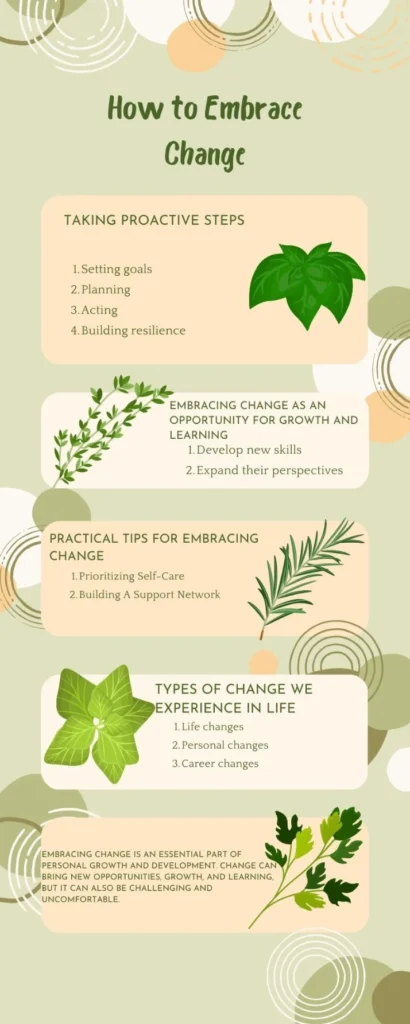Change is an ever-present part of life that takes many forms. It can range from small transitions like learning a new skill to significant life events such as starting a family, switching careers, or moving to a new home. While change is unavoidable, our experience varies greatly depending on how we relate.
By learning to embrace change, we turn an intimidating foe into an ally for growth. This essay will explore strategies for embracing change to live fuller, more dynamic lives.
First, we must clearly define what is meant by change. Put adaptation refers to making the status quo different. It is any shift in life circumstances, environments, or within oneself.
Change disrupts the predictable and thrusts us into unknown territory. Our fundamental nature seeks security, so change often provokes discomfort and resistance. However, change also presents new possibilities. Without it, life becomes stagnant.
Second, change is unavoidable. From birth through death, our lives are in flux. Each day brings new developments. As Heraclitus said, “The only constant in life is change.”
We cannot escape change but only choose how to respond. Embracing change means actively engaging with this reality rather than fighting the inevitable.
Third, learning to embrace change is essential for growth and fulfillment. It allows us to evolve mentally, emotionally, and spiritually. Through life’s transitions, we gain wisdom, resilience, and perspective that enrich our self-identity. Embracing change is what propels us forward.
This article (How to Embrace Change) will explore practical strategies for embracing change in various life domains. Key topics will include transforming perspective, learning from change, building support systems, leveraging strengths, and maintaining flexibility.
By implementing these approaches, change becomes an opportunity rather than an obstacle. The following sections will provide actionable ways to thrive through life’s inevitable transitions.
The Benefits of Embracing Change
Embracing change offers individuals and organizations a myriad of benefits, ranging from personal growth and adaptability to enhanced innovation and problem-solving skills, creating a transformative landscape of opportunities and development. Let’s read some of them in detail:
Personal Growth and Development
Embracing change leads to immense personal growth and development. By leaning into change, we continuously expand our skills, abilities, and perspectives. Change pushes us outside our comfort zones and deepens wisdom through firsthand experience.
For example, starting a new career in an unfamiliar industry forces learning new technology, adapting communication styles, and expanding networks.
This builds tangible competencies while growing intangible qualities like confidence, empathy, and strategic thinking. Significant life changes are catalysts that spark rapid maturation and self-discovery.
Even incremental changes like learning a new hobby build neural pathways, flexibility, and a growth mindset to apply elsewhere. By embracing change’s call to growth, we evolve consciously rather than stagnate in complacency.
Adaptability and Resilience
Embracing change also increases resilience and adaptability. Resilience is the ability to recover from setbacks and flexibly respond when plans fall apart. Change provides opportunities to cultivate resilience before high-stakes situations.
Through small challenges, we build determination, optimism, and the capacity to handle obstacles. For example, persevering through a problematic fitness program strengthens mental grit to push through other changes.
Adaptability – adjusting to new conditions – is also honed through transition. We learn how to accommodate different personalities, work dynamics, and environments.
Becoming comfortable with the unfamiliar makes us more versatile overall. Together, resilience and adaptability are invaluable assets that allow us to navigate life’s inevitable ups and downs.
Innovation and Creativity
Innovation and creativity thrive when we embrace change. The openness required to welcome change fosters original thinking and solutions. Without change, minds stay closed in established patterns.
But when we appreciate differences, our mental frameworks stretch, and resources are freed up for novel ideas.
Change diversifies perspectives, bringing more vantage points. It also catalyzes resourcefulness — necessity forces creative problem-solving. Many great inventions and art emerged from instability because uncertainty wakes the imagination. By learning to ride change’s waves, we tap into the source of human innovation.
Improved Problem-Solving Skills
Finally, embracing change hones critical problem-solving skills. Change presents puzzles to decipher and challenges to navigate. With an open, curious mindset, these become opportunities to cultivate problem-solving. We learn to gather information, analyze systems, weigh trade-offs, troubleshoot barriers, synthesize solutions, and tolerate ambiguity.
While typically seen as a threat, change is a safe space to build skills, like a mental playground. Developing sound problem-solving prepares us to handle dilemmas in work, relationships, and achieving goals. Change provides endless opportunities for this growth.

How to Embrace Change and Thrive
Change is inevitable. Whether in our personal lives or at work, change is constantly happening. For many people, change can be challenging to deal with. It can create uncertainty, stress, and discomfort. However, change also provides growth opportunities.
By learning to embrace change, you can turn it into a positive force. In this article, I’ll walk you through strategies to help you not just cope with change but genuinely embrace it.
Overcome Resistance and Fear
The first step is acknowledging that change can provoke resistance and fear. It’s completely natural to want to cling to the familiar. Dramatic change can feel threatening. Even positive changes can be challenging at the moment. Recognizing these instincts is essential.
Remember, you always have a choice in how you respond. You can let resistance prevent growth or see it as a signal to move forward mindfully. Start by identifying what precisely you find threatening about the change. Then, focus on the potential benefits. There are always opportunities, even if they need to be clarified.
Adjust Your Mindset
How you think about change heavily influences how you experience it. Adjusting your mindset takes awareness but can make a huge difference.
Adopt a Growth Mindset
Psychologist Carol Dweck describes two core mindsets – fixed and growth. With a fixed mindset, you see your abilities and intelligence as set. You may resist change to protect how you see yourself. With a growth mindset, you see yourself capable of continual improvement. You’re more open to challenge and change.
Catch yourself when you have fixed mindset thoughts like “I could never do this.” Instead, tell yourself, “I’m excited to learn how.” This slight mindset shift primes you to grow.
Focus on Possibilities
When change happens, it’s easy to fixate on what’s lost rather than the possibilities ahead. Intentionally shift your focus. What new opportunities does this change allow for? What strengths can you build through this transition?
See Change as Temporary
Significant changes can feel like permanent upheaval. Remind yourself that heightened emotions and discomfort are temporary. You need time to process and adapt. This mindset reduces stress and enables more transparent decision-making.
Make an Active Decision
Rather than just reacting, make an active decision about how you will relate to the change. Consider if you will accept, avoid, or challenge the difference.
Acceptance doesn’t mean you necessarily agree or won’t feel complex emotions. It means acknowledging the reality so you can move forward.
Avoidance can be helpful to give yourself space temporarily, but long-term blocks growth.
Challenging The change may be an option sometimes, but assess whether it ultimately serves you.
Once you’ve consciously made a decision, you can stop passively resisting. Active intention reduces inner turmoil.
Get Curious
Curiosity is an antidote to fear. When you feel resistance or uncertainty, get curious. Avoid ruminating on worst-case scenarios.
- What might I gain through this change?
- How could this change be meaningful if I embraced it?
- What strengths or abilities might I develop?
Ask questions instead of making declarations. Curiosity opens new possibilities. It’s okay not to have all the answers yet. You have time to navigate thoughtfully.
Progress in Small Steps
Significant changes are digestible when broken into small steps. Feel overwhelmed? Break it down.
- What’s one small step you could take today?
- What resources or support could help with this specific piece?
- What part of this change is most within your control?
Small concrete progress gives a sense of capability to build on. Be patient with yourself. Small steps in a good direction add up.

Explore Options Creatively
Uncertainty allows creativity to flourish. When things are open or unresolved, it’s a chance to explore options. Avoid locking in on one approach too quickly.
- What are multiple ways you could respond to or move through this change?
- What would you suggest to a friend in this situation? Look at it from the outside.
- What would a fun or creative solution be, even if it seems impractical? Allow yourself to brainstorm widely.
Applying creativity reduces rigidity. More possibilities emerge when you allow yourself to think broadly.
Identify Lessons and Gifts
Every change holds lessons and gifts if you’re willing to look for them. Reflect on how this change benefits you, even in ways not immediately apparent.
Does it prompt you to:
- Gain knowledge or skills?
- Clarify priorities and values.
- See things more clearly?
- Deepen relationships?
- Improve habits?
- Discover hidden abilities or courage?
Consciously acknowledging lessons and gifts makes the change more meaningful.
Release Control
The unknown can be scary. We want to control outcomes for security. However, manipulating circumstances blocks growth. Practice:
- Releasing the need for certainty
- Tolerating discomfort
- Allowing events to unfold naturally without jumping into control
This builds trust in yourself to handle what arises. You don’t need tight control. You have the strength to navigate uncertainty.
Support Your Well-being
Tending to your well-being helps you manage change gracefully. Prioritize:
Rest and recovery – Get enough sleep. Schedule downtime. Balance activity with renewal. When stressed, rest is protective.
Healthy nutrition – Eat grounding, nourishing foods. Reduce caffeine, sugar, and alcohol that deplete you. Hydrate and support your body.
Movement – Exercise, stretch, walk, dance. Moving your body releases tension and elevates mood.
Time in nature – Spend time outdoors, away from screens and people. Nature has direct healing impacts.
Stress management – Try meditation, deep breathing, yoga, or mindfulness. Find ways to relieve stress each day actively.
When you support your well-being, you have the energy to navigate challenges. Pay attention to your core needs.
Connect with Community
You don’t need to face change alone. Support others going through similar changes. Share ideas and strategies. Even just listening helps normalize your experience.
Or connect with someone further along. They understand and can point out unseen progress. Look for mentorship to guide you. Supporting others also boosts your strength. Change links us to shared humanity.
Engage Your Values
Significant changes can lead to questioning your self-identity. Reaffirm what matters most to you.
- What personal values anchor you through this transition?
- How will embracing this change allow you to live your values?
- What parts of your identity remain untouched?
Connect with your integrity. Let values guide decisions and strengthen resilience. You remain you amidst any external shifts.
Envision Possibilities
When the path forward seems hazy, envision desired possibilities. Imagine how you would like things to turn out.
- What are you working toward through this change process?
- What is the vision that will motivate you on difficult days?
- How can embracing this change help achieve a future goal?
Hold this vision gently. Progress towards what you wish without attachment to specifics. Your intentions plant seeds from opportunities that can sprout from.
Appreciate Your Strengths
Recognize the resources you have to work with. You likely need to pay more attention to your capacity. Consider:
- Past changes you have worked through successfully
- Skills or traits that will serve you well now
- People and support you can rely on
You are more capable than you know. Have faith in yourself. You’ll grow in ways not possible without this change process. Trust your inner resources.
Find Your Courage
Courage comes in many forms. Every small brave act builds your reserves. Start by identifying where you feel most unsure. Then consider:
- What would be one tiny brave step towards growth without too much discomfort?
- How can you gently encourage yourself to shift out of your comfort zone?
- What supports or people could help scaffold you?
Courage is like a muscle. With small acts of courage, you build confidence to respond bravely to life’s changes.
Allow Time to Integrate
Be gentle with timelines. Allow things to integrate and unfold gradually. Change takes time to absorb. Have realistic expectations for processing.
- Imagine you had a friend going through this change; what advice might you offer? Likely, you would remind them to be patient with themselves!
- Notice judgments about “not being far enough along.” Self-acceptance is key.
- Release attachment to an ideal schedule. Progress ebbs and flows. Much happens beneath the surface, even when we feel stuck.
You may feel more peaceful about the change later. But with time, you build the capacity to integrate it into your life.
Transform Perspective
Look at the situation from new angles. Ask:
- How would my best self respond to this change? Act as if you were your ideal self.
- If I pretended I was excited about this change, how might I behave?
- How is this an experiment or adventure rather than a threat?
Any experience is workable, depending on your perspective. Be open to shifting your vantage point. This flexibility and curiosity will serve you well.

Use Change as a Catalyst
Rather than just reacting, use change as a catalyst for intentional growth and reflection. Ask yourself:
- What old habits or limiting beliefs does this change allow me to release?
- How can I rearrange my priorities and time to align with what matters most?
- What parts of my life no longer serve me that this transition allows me to let go of?
Be proactive. Channel the momentum of change toward your development. Significant life changes can clarify what is essential. Use this clarity to fuel positive personal shifts.
Reframe the Narrative
The story you tell yourself about change shapes your experience. Notice how you describe the transition to yourself:
- Does the narrative emphasize struggle and loss or possibility?
- Are you the victim of circumstance or an active hero of your journey?
- Is this a problem to be solved or a mystery to explore?
Reframe the narrative when needed. Write a new story that empowers. Find the gifts in each step. You are the author who decides the tone.
Acknowledge Grief
The significant change involves loss. Give space for grief – for aspects of your life or endings. Feelings like anger, sadness, or disappointment are normal. Acknowledge failures openly rather than minimize them.
Process these feelings. Talk to supportive people. Express yourself through writing or creativity. Rituals and ceremonies can provide closure. While allowing grief, keep the perspective that this is just one chapter in your ongoing story.
Respond With Flexibility
You will likely vacillate through many emotional states during change. Expect ups and downs, steps forward and back. Meet each moment flexibly.
Your mood will shift. Thoughts will change. New events will occur. Respond to each moment as a fresh opportunity. Embrace the impermanence. Allow whatever arises with equanimity and compassion for yourself.
Flexibility allows you to pivot as needed without attachment to any one view. Each moment brings new potential.
Access Inner Wisdom
Listen to your inner voice for guidance during change. Intuition offers unique wisdom. Make space for reflection through:
- Quiet contemplation
- Mindful walks
- Time in nature
- Silent meditation
- Journaling
- Artistic expression
What messages bubble up when you pause external noise? What new perspectives or insights emerge when you listen within? Seek balance between inner and outer guidance.
Remain Hopeful
When change gets difficult, hope uplifts. Reach for inspiration by:
- Recalling past examples of how things worked out, even when you couldn’t initially see how.
- Looking for everyday signs you’re headed in a positive direction.
- Affirming that you have the strength and support to navigate this.
- Connecting with faith in your resilience.
- Imagining how you may feel when you look back with pride.
Hope fuels motivation when energy is low. You’ve made it through before. You will again. Believe in your capacity.
Real-Life Examples of Embracing Change
There are many inspirational cases of individuals and organizations who have successfully embraced change. Jim Harris was a successful corporate executive who experienced a massive heart attack in his 30s.
This health crisis prompted significant lifestyle changes, including shifting to a plant-based diet, meditating regularly, and dedicating his career to environmental activism. By viewing the heart attack as a catalyst for positive change, Harris transformed his health, personal life, and career trajectory.
On an organizational level, Netflix exemplifies embracing change and innovation. As technology and consumer preferences quickly evolved, Netflix transitioned from mailing DVD rentals to pioneering online video streaming.
This required significant changes to its business model and infrastructure. By proactively embracing new technology instead of resisting change, Netflix could ride the digital wave rather than becoming obsolete.
The United States military has also integrated mindfulness, emotional intelligence, and positive psychology to improve soldiers’ resilience, mental health, and adaptability to challenging conditions. By creating a culture that embraces change as an opportunity for growth, the military equips people to thrive through adversity.
Lessons Learned
These cases illustrate that by embracing change skillfully, we can catalyze profound personal and organizational evolution. Key lessons include: Being open to change rather than resistance. Looking for opportunities in disruption. Using change as a driver for growth. Creating cultures that are flexible and forward-thinking.
Individuals and organizations that learn to see change as a teacher and ally are best positioned to gain from life’s shifts rather than being overcome by them. We have a choice – allow change to happen to us or consciously harness its transformational power.
Conclusion – How to Embrace Change
Approach change with the expectation of growth. Believe that with time and intention:
- You will become more skilled, wiser, and more robust.
- Your sense of self and purpose will expand.
- Doors will open that you couldn’t have imagined.
- You will be grateful for the journey.
Know deep down that significant changes challenge us for a good reason. Trust in your ability to learn and grow. If you remain open, change leads to blossoming.
The path of personal growth and change is never complete. There will always be challenges to face. By bringing courage, flexibility, and heartfulness, you can harness the transformational power of change.
Be patient and gentle with yourself, but keep moving. With an open mindset, change becomes your friend that guides you to new levels of possibility.
Change is problematic because it represents uncertainty, and our brains are wired to prefer predictability and security. Change disrupts our habits, expectations, and identities. It requires cognitive flexibility and adaptability, which can feel uncomfortable.
Common reactions include shock, denial, anger, bargaining, anxiety, sadness, resistance, immobilization, demotivation, frustration, and fear. Only some people respond to change initially with excitement or enthusiasm.
Strategies include adjusting your mindset to be growth-oriented, breaking change into small steps, self-care during transitions, reframing the narrative about change, leaning into curiosity over fear, seeking support, and intentionally building resilience skills.
While comfort has appeal, resisting change leads to stagnation and prevents personal growth. Embracing change is essential for developing new skills, perspectives, and capabilities. Change brings opportunities that enhance our lives.



